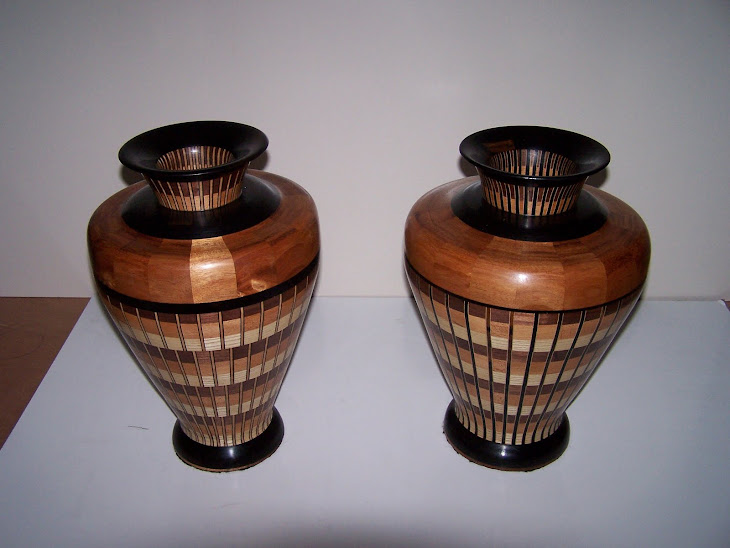


My Grandfathers Lathe is an educational blog designed to empower the average wood worker with the humblest of shops to do above average work and generally leap tall buildings in a single bound. Weather lathe work or flat work and points in-between, my hope is that there may be something here for you.



Creating these designs is probably the most difficult wood work I have ever done. It is not in the turning but creating the material. I might spend 8 to 10 hours creating material that takes 30 minutes to turn. Consistency is also a large problem along with minimizing cumulative error in the material. Glue up jigs are a must to keep the glue up from sliding and moving on the triangular matterial.
Running 8 inches of material through 4 inches of table saw blade is a scary proposition. So heads up, if you go down this path you need to be extra carefull. Be sure and count the # of fingers you have before you start. After, if the number is in any way different be sure and tell your wife she was right. An easir solution would be a 12 inch table saw but who can afford that, right?
The problem lies in cutting on the bias. A 45 degree is nice, less is better. A 30 gives you a bigger ‘eye ball’ so to speak as the vessel on the right vs the 45 degree bias on the left. You can see this in the material next to each which are the scraps of the original material.
These vessels are created with 4 pieces with 2, 45 degree cuts each. Allowing the 4 piece construction is trickier to get perfect seams and connections perfect (which gives you the most dramatic look) but the longer slices of the pie make the slopes and curves more dramatic. Of course because you are turning a quarter of the round by the time you come to the end you are into end grain, augh as can be see in this close up. But using a more end grain sensitive matterial (unlike this walnut) can get you the best of both worlds as with the butternut. The benifits with the 4 piece construction are well worth it. the design as the pieces come together is the 'big wow' you are looking for. You can get the owl eye look or LA freeway look and and combination thereof depending on how you align the joining ends. It requires experimentation for sure. I often was suprised with what waited for me inside the wood by way of design.



My last posting we talked about some experiments with plywood. Honestly I was not impressed with the results but as in all things one idea takes you to the next thing. In this case it was laminates with segmentation which can be applied is so many ways with so many different variations that the combinations are limited only by your imagination.
Here are some pic's of where this has taken me.
It is koa wood from Kauiai with maple highlights and a curly maple top and bottom.
It was made by one of my best friends, Timothy my 19 year old son who just got back from
I came upon the OATS design through George Guadiane who can be found at ‘TurnedByGeorge.com’




